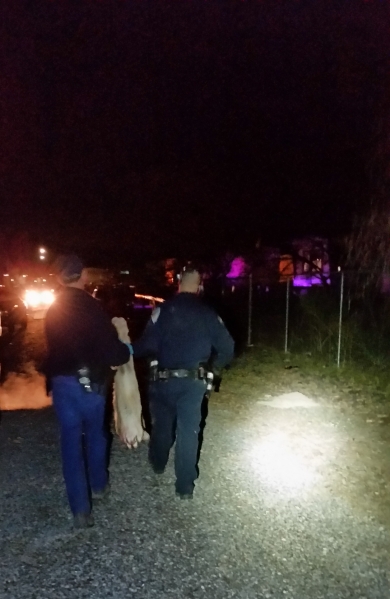
The directive to kill a mountain lion in Pahrump came from the Nevada Department of Wildlife, not the Nye County Sheriff’s Office, as first reported.
Animal Control Officer Susan Ryhall, also at the scene, said the directive came from a game warden with the state who was summoned to the location at West and Long streets.
Ryhall noted after evaluating the animal’s behavior, the game warden said the cat could not be tranquilized and released in a remote location.
“I just want to emphasize that the sheriff did not want that cat killed,” Ryhall said. “The sheriff adamantly said she did not want that cat killed. The warden made the decision that the animal would not, under any circumstances, be a candidate for relocation because it had lost its fear of humans.”
Additionally, she said there was plenty of evidence to determine someone in the neighborhood was feeding the cat.
“There were food bowls located inside of her den after she was dispatched,” Ryhall said. “There is no question somebody was feeding the cat, which is probably why she lost her fear of human beings.”
Aside from getting fed by humans, the cat, according to Ryhall was adept at getting its own food at the location.
It’s unknown how long the mountain lion took up residence in the heart of the community.
“There was a fresh kill at the site,” she said. “She had a house cat that she had just killed and buried under some twigs. The cat was still wet with saliva and that’s how fresh the kill was. She still had blood on her mouth from killing the cat.
Officials onsite deliberated for quite some time on how they could safely remove the cat.
The entire operation took several hours.
“After coming out and evaluating the cat’s behavior as well as the den site, the game warden determined that this cat had lost all fear of humans, which made it a danger to human beings,” she said. “The game warden said they could tranquilize the cat and take it 200 miles away, and within 3 to 4 days, that cat would be right back at the site. The game warden actually said that they would not tranquilize and relocate the cat.”
Aside from not showing fear toward humans, Ryhall said even the clamor of emergency vehicle lights and sirens, two-way radio traffic and a helicopter hovering above the location did not appear to frighten the feline.
“I cannot say whether it was someone’s pet, but what I can say, is that the cat had no fear of anyone on the scene,” she said. “There were dogs barking in the neighborhood and she had no fear of that as well. She was comfortable laying there with all of the commotion going on as a typical house cat would be.”
Tranquilizing and removing the animal was not an option.
Ryhall said there were considerable concerns the mountain lion could flee into the darkness after being hit with a tranquilizing dart.
“They ran into the risk of tranquilizing her and her taking off,” she said. “We then would have a lost, tranquilized, mountain lion in town. The decision was made by the game warden to dispatch her right there at the site because it was the safest thing they could do. In my opinion, trying to use a catch pole would be ridiculous. These animals are solid muscle, and for somebody to try to use a catch pole on it, I can’t imagine that.”
Outside of visiting the zoo, Ryhall said Monday was the first time she’s encountered a mountain lion while serving as an animal control officer.
She also said it may not be the last time, as there are many others in town. “There are probably about 50 other mountain lions living amongst us in the valley, staying elusive and being unseen. This cat was coming out in the middle of daylight right in the center of the neighborhood and in the center of town hunting for domestic animals.”
Ryhall said ‘startled,’ did not begin to describe her feelings after first spotting the mountain lion out of the side of her eye.
She noted the mountain lion never hissed, growled or snarled and actually began licking her paws.
“It’s kind of like coming face to face with a loaded gun,” she said. “There’s an animal 10 feet in front of you, which could end your life right there with one leap. She just blended in with her surroundings and her coat matched the bamboo that surrounded her den site. She saw me well before I saw her. With any predator, you want to stay calm and you do not want to turn your back on it. You should just back out of the area and give the animal space, and that’s what I did.”
Once the mountain lion was dispatched, Ryhall said a pall of anguish fell upon everyone on scene.
“Nobody wanted that cat killed,” she said. “The hope was that this cat could be tranquilized and relocated. The game warden has been one for 18 years and he said this is the first time he’s ever had to kill a mountain lion. There was not one person there that was not emotional about having to kill the cat. I want to state again that our sheriff absolutely did not want that cat killed and she made it very clear to the game warden.”
Ryhall also reminded residents about the dangers of feeding wild animals, be it a mountain lion or coyotes.
“If people want to save the lives of these wild animals, they should just leave them alone and stop feeding them,” she said. “They should stop intervening because the animals know how to survive on their own. If it were not for human intervention, this animal would probably still be alive.”
-Contact reporter Selwyn Harris at sharris@pvtimes.com